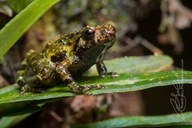|
Description
The smallest Anodonthyla. M 15-17 mm, F 15 mm. Tympanum indistinct, 1/2 of eye diameter. Tibiotarsal articulation reaches the eye. Toe 3 longer than toe 5. Skin smooth with a number of larger tubercles. Dorsal colour variable but usually with a shade of green, often with symmetrical darker markings. Ventrally olive green to grey (Glaw and Vences 2007).
Similar species: Most similar to A. boulengeri which can live in close syntopy but usually has no green colour and has a faster repetition rate of notes in advertisement calls (Glaw and Vences 2007).
Distribution and Habitat
Country distribution from AmphibiaWeb's database: Madagascar
So far, this species has been recorded only in the Ranomafana region in southeastern Madagascar: from Ranomafana village (c. 550m asl) to the Kidonafo bridge near Vohiparara (1000m asl). Despite intensive surveys in the central-eastern rainforests around Andasibe and Moramanga, this species has never been seen or heard in these sites. Nevertheless, it most likely occurs in additional locations beyond Ranomafana, but it is probably a regional endemic to southeastern Madagascar (Vences and Andreone 2008).Life History, Abundance, Activity, and Special Behaviors
Habits: Males call at night on tree trunks at perch heights of 0.5-1.5 m. During the day found in tree holes or under moss layers on tree trunks (Glaw and Vences 2007). Close to Ranomafana village, this species was found in acoustic syntopy with Anodonthyla boulengeri. It presumably breeds in tree holes by larval development (Vences and Andreone 2008).
Calls: A single short melodious note, repeated after regular intervals in long-lasting series. Note repetition rate 35-55/min (Glaw and Vences 2007).
Trends and Threats
Although it occurs in a well-protected area, the Ranomafana National Park, it might occur more widely in habitats that are much less secure. However, it appears able to adapt to secondary habitats, at least to some extent. Its probable small (or at least discontinuous and patchy) distribution also raises some concerns about its conservation status (Vences and Andreone 2008).
Comments
Taken with permission from Glaw and Vences (2007) and Vences and Andreone (2008).
References
Glaw, F., and Vences, M. (2007). Field Guide to the Amphibians and Reptiles of Madagascar. Third Edition. Vences and Glaw Verlag, Köln.
Vences, M. and Andreone, F. (2008). Anodonthyla moramora. In: IUCN 2008. 2008 IUCN Red List of Threatened Species. www.iucnredlist.org. Downloaded on 01 May 2009.
Originally submitted by: Miguel Vences and Frank Glaw (first posted 2009-05-01)
Edited by: Kellie Whittaker (2010-07-18)Species Account Citation: AmphibiaWeb 2010 Anodonthyla moramora <https://amphibiaweb.org/species/6568> University of California, Berkeley, CA, USA. Accessed Jun 1, 2025.
Feedback or comments about this page.
Citation: AmphibiaWeb. 2025. <https://amphibiaweb.org> University of California, Berkeley, CA, USA. Accessed 1 Jun 2025.
AmphibiaWeb's policy on data use.
| 